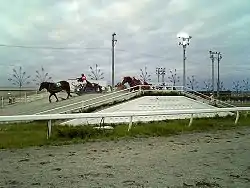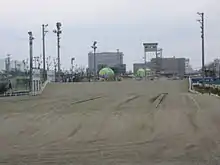Ban'ei
Ban'ei kyōsō (ばんえい競走, lit. "pull race") is a form of Japanese horse racing in which draft horses pull heavy sleds up sand ramps, urged-on by jockeys balancing on the sleds. The horses used in the races are often either purebred or crosses of Percheron, Breton, and Belgian breeds.[1][2]
 | |
| Highest governing body | National Association of Racing |
|---|---|
| First played | c. 1900 |
| Characteristics | |
| Contact | No |
| Type | Horse driving |
| Equipment | Weighted sleds |
| Venue | Dirt racetrack |
| Presence | |
| Country or region | Tokachi, Japan |
As the popularity of the races has waned in recent years, regular ban'ei races are only held at the Obihiro, Hokkaido racecourse.[3][4]
History
Ban'ei racing has its probable origin in agricultural work, when horses were used to pull farming machinery and sleds of wood. Eventually, the horses were tested for speed and strength in festivals of the late Meiji Era (c.1900).[5]
The popularity grew; in 1953, Hokkaido's four cities (Kitami, Asahikawa, Iwamizawa, and Obihiro) began to manage races. The former three closed operations in 2007 due to declining revenues. Obihiro racecourse is now the only one currently active, hosting races most Saturdays, Sundays, and Mondays. Races are also held on more days to mark special occasions, such as New Year's Day,[6] and there are many regional races known as ban'ei koshien.
The Obihiro racecourse nearly closed in 2006 before Softbank, a Japanese mobile phone company, provided funds for the races to continue.[7] Odds Park Cup race, named after the internet-betting subsidiary of Softbank, was established in 2007 as an expression of gratitude.[8] Other companies, such as Rakuten[9][10] and Sapporo Breweries[11] have added their sponsorship and several support schemes have been initiated, including a race-sponsoring scheme for individuals.[12]
Overview

The ban'ei course consists of a 200 metres (660 ft) dirt track with lanes separated by ropes laid in the sand. This creates ten lanes, each incorporating a starting gate and two hill-shaped obstacles. The second and steeper obstacle is called the Ban'ei Point. Horses haul sleds across this track, with the weight of each sled ranging from 450 kilograms (990 lb) to 1 ton, as seen in the Ban'ei Kinen event.[13]
Jockeys stand and balance on the sled, using long reins as a whip and weight slabs under the feet of the jockey in place of a saddle. Each jockey must weigh at least 75 kilograms (165 lb); if the jockey is underweight, slabs are added to meet the smallest weight.[13] Horses are often deliberately stopped after the first obstacle, and given a chance to rest before being ushered to climb the second. A horse has not finished until the entire sled is behind finish line.
After the race completes, racehorses are freed from the sleds and led to the back yard, while the sleds are returned to the starting gate with the aid of a trolley.[13] The amount of weight a horse must pull is determined by several factors, with younger horses and mares pulling less than older horses and stallions. A horse's group and rating—which further determines the required weight—depends upon the amount of money the horse has previously earned. Horses compete in groups labeled 1–26, and groups are rated with Open, A1, A2, B1, B2, B3, B4, C1, C2 or D (in order of decreasing winnings).[14] This is like system used in Japanese thoroughbred racing. The weight allowance of jockeys is either 10 or 20 kilograms (22 or 44 lb), based on the number of wins.[14]
Because ban'ei racing is about strength and not speed, the winning time of major races is often slower than lower-class races, where even a small overtime can have a horse disqualified.[15][16] With suitable ground conditions, horses pulling lightly loaded sleds can clock speeds under 50 seconds.[17][18] The condition of the track is described using measured-moisture percentage.[19] The track is repaired manually during or between races. Watering is used to prevent excess dust from irritating horses and people.[20] Heating systems allow racing during the winter months.[21]
Horses

Horses in ban'ei are often either purebred or crossbred variations of Belgian, Breton, or Percheron draft horses.[2] Their weight can surpass one ton, twice the weight of a thoroughbred.
Stock
Potential stock is chosen from draft horses raised for meat.[22][23] Most ban'ei horses start official racing as two-year-olds after passing inspection held between April and August.[24] Regional races ("ban'ei koshien") with finals for yearlings are held in October.[25][26] Horses that do not pass inspection are either sent back to a breeder as they can be used in events or tourism,[27] or to feedlot.[13]
Competing horses are mainly solid-coloured, but there have also been pinto ban'ei horses[28][29][30] and two dominant whites.[31][32][33][34]
Former racehorses not eligible for breeding are usually[35] sold for meat.[7] At the close of every fiscal year during the end of March, prolific retiring racehorses are honoured at their own ceremony. The National Association of Racing (NAR) annually awards the best horse.[36]
Japanese draft horse
The Japanese draft horse is a breed with open studbook created by crossing purebred and half bred horses together for five consecutive generations. Horses that don't meet this requirement have been registered since 2003 as half-blood draft horses.[37]
Eight draft breeds have been listed as eligible for the breeding program: Ardennes, Clydesdale, Shire, Brabançon, Breton, Boulonnais, Belgian and Percheron.[38] This is not directly comparable to breeding stock available. As of 2015, purebred stallions in stud are Bretons and Percherons,[39] while data about new registrations of broodmares from 2014 indicates that from purebreds, three form most: Bretons, Percherons, and Belgians.[40]
Japanese drafts are used mainly in ban'ei and horse meat production.[39][41] The ideal horse has draft phenotype and "hybrid vigour".
The breed doesn't have any colour or marking specifications. Colours of bay, chestnut, flaxen chestnut, black, gray and variety of roans have been recorded since they also exist in purebreds.[42] In extreme cases, a horse may have multiple facial markings and all legs marked with white. Open studbook policy has led to pinto (piebald) pattern; one female family[43] used in ban'ei can be traced to single stallion born in 1967,[44] while dominant white seen in two horses was spontaneous, manifesting in 2010. Prevalence of hereditary diseases is unknown, since at least one Western scientific source lists breed as "ban-ei" without hereditary diseases.[45]
References
- "English -Banei Tokachi WebSite". Archived from the original on 2014-02-27.CS1 maint: bot: original URL status unknown (link)
- JEAA Stallion Registration Regulations Secretary bylaws JEAA lists eight breeds that can be used to breed horses for ban-ei: Ardennes, Clydesdale, Shire, Brabançon, Breton, Boulonnais, Belgian and Percheron. ("アルデンネ、クライズデール、シャイヤー、ブラバンソン、ブルトン、ブーロンネ、ベルジアン、ペルシュロン")
- Racing Statistics 2005–2015 (Racing by Local Governments)(in English)
- Archived 2017-04-19 at the Wayback Machine Racing by Local Governments in Japan 2016 – Ban-ei (Draft Horse Racing)(in English)
- ばんえい競馬の歴史
- 年間開催日程
- A Horse-Racing Tradition Lumbers Into Its Final Stretch New York Times article on Ban'ei racing published 25 December 2006, accessed 24 October 2011
- ばんえい十勝オッズパーク杯
- 第49回楽天競馬ばんえい応援賞B4-2
- "ばんえい十勝応援企画2016第2弾:おトク情報:楽天競馬".
- サッポロビール賞シルバーカップA1・A2混合
- 個人協賛について
- ばんえい競馬コラム(Archived from the original on May 11, 2009. Retrieved September 4, 2016)
- 平成28年度 帯広市ばんえい競馬番組編成要領
- Disqualification in normal race – weight 480kg, time 3:57:5, winner's time 1:50:6
- Winning times of Ban'ei Kinen(since 1973) – several times over four minutes
- Hokushou Battle: 490kg in 0:44:3
- Oidon: 490kg in 0:47:6
- Example record of scale used (after horse is retired, scale rating is changed to one used in thoroughbred racing)
- 【お知らせ】走路散水について(5/23)
- 【お知らせ】本走路のヒーティング稼動および砂障害の撤去
- 88% percent of this industry is concentrated to Hokkaido and trend is decreasing.(pg. 2, classification "農用馬")(Japan's Ministry of Agriculture, Forestry and Fisheries)
- 馬の改良増殖等をめぐる情勢 平成26年6月(pg. 2, 8.)(Japan's Ministry of Agriculture, Forestry and Fisheries)
- "【平成28年度 能力検査について】ばんえい十勝オフィシャルホームページ". Archived from the original on 2016-06-01. Retrieved 2016-04-30.
- "【お知らせ】10/25~26全道祭典ばんば1歳馬決勝大会-ばんえい十勝オフィシャルホームページ". 22 March 2015. Archived from the original on 22 March 2015.CS1 maint: bot: original URL status unknown (link)
- 馬 – 2006
- "駁毛(ぶちげ)のエンジェルガガ デビュー – ばんえい十勝スタッフブログ".
- "異色対決 – ばんえい十勝スタッフブログ".
- "ガンバレ、がんばる! – ばんえい十勝スタッフブログ".
- "704kg ハクバビューティー – ばんえい十勝スタッフブログ".
- "ハクバビューティー、負けん気爆発! – ばんえい十勝スタッフブログ".
- "7月3日(日) ハクバボーイ – ばんえい十勝スタッフブログ".
- JEAA journal issue 6 from 2011 where Hakuba Beauty (then known as "Hakubahime") is gene-tested for W17. (pg. 6)
- Ban-ei horse with second career as carriage horse
- (in English)
- 輓系馬の部(pg. 3)
- 輓系馬の部(pg 2.)
- 繁殖登録雌馬の品種構成
- 輓系馬等の交配に伴う品種名一覧 They are also used in breeding of heavy crossbreds(輓交種) and Japanese Horse
- 実馬審査体型標準 – 輓系馬
- Pedigree of Almond Madonna, dam of Angel Gaga
- Hanuma
- UFAW Electronic Supplementary Material – Appendices Horse breeds with inherited disorders
External links
| Wikimedia Commons has media related to Ban'ei. |
- Archive of Official NAR Video site(note: livestream only in Japan)
- BANEI THEATER
- Pen International: Ban'ei Horse Racing